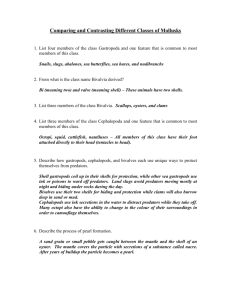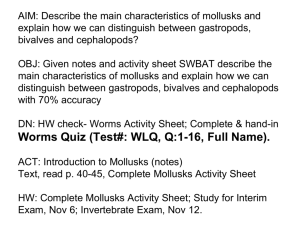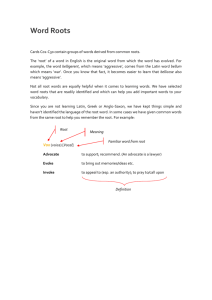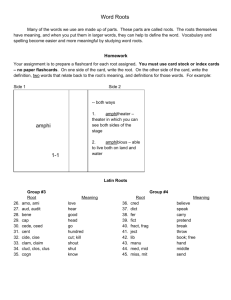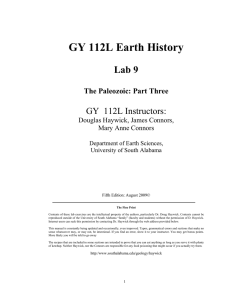Domains, Kingdoms, Classification Study Guide (Part 2)
advertisement
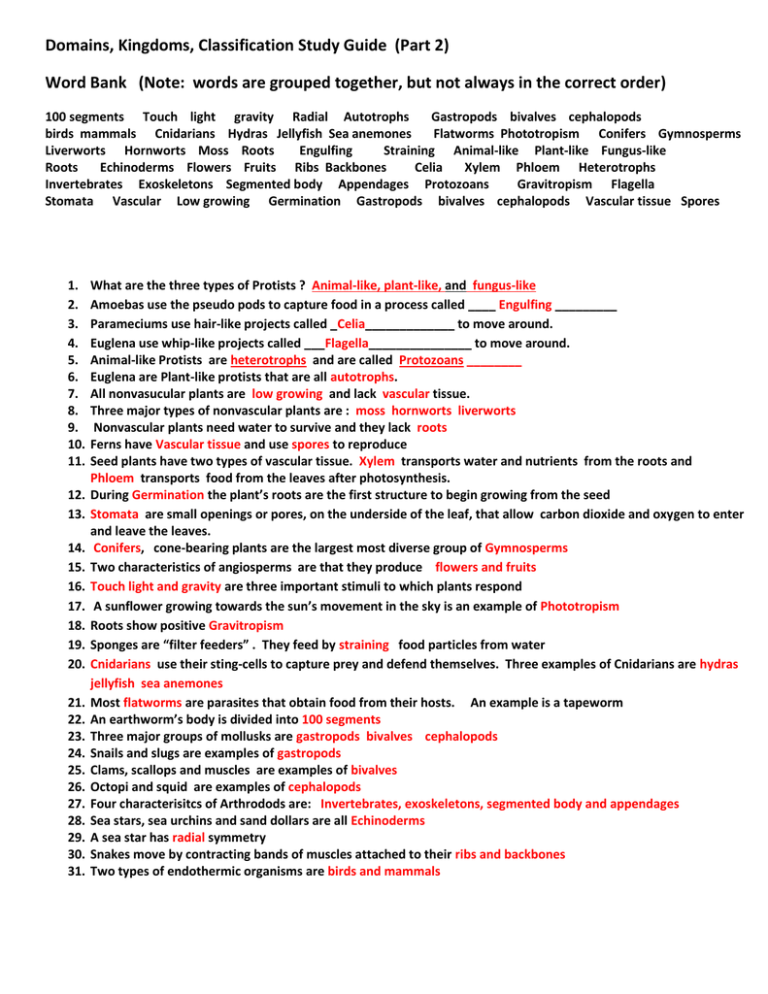
Domains, Kingdoms, Classification Study Guide (Part 2) Word Bank (Note: words are grouped together, but not always in the correct order) 100 segments Touch light gravity Radial Autotrophs Gastropods bivalves cephalopods birds mammals Cnidarians Hydras Jellyfish Sea anemones Flatworms Phototropism Conifers Gymnosperms Liverworts Hornworts Moss Roots Engulfing Straining Animal-like Plant-like Fungus-like Roots Echinoderms Flowers Fruits Ribs Backbones Celia Xylem Phloem Heterotrophs Invertebrates Exoskeletons Segmented body Appendages Protozoans Gravitropism Flagella Stomata Vascular Low growing Germination Gastropods bivalves cephalopods Vascular tissue Spores 1. 2. 3. 4. 5. 6. 7. 8. 9. 10. 11. 12. 13. 14. 15. 16. 17. 18. 19. 20. 21. 22. 23. 24. 25. 26. 27. 28. 29. 30. 31. What are the three types of Protists ? Animal-like, plant-like, and fungus-like Amoebas use the pseudo pods to capture food in a process called ____ Engulfing _________ Parameciums use hair-like projects called _Celia_____________ to move around. Euglena use whip-like projects called ___Flagella_______________ to move around. Animal-like Protists are heterotrophs and are called Protozoans ________ Euglena are Plant-like protists that are all autotrophs. All nonvasucular plants are low growing and lack vascular tissue. Three major types of nonvascular plants are : moss hornworts liverworts Nonvascular plants need water to survive and they lack roots Ferns have Vascular tissue and use spores to reproduce Seed plants have two types of vascular tissue. Xylem transports water and nutrients from the roots and Phloem transports food from the leaves after photosynthesis. During Germination the plant’s roots are the first structure to begin growing from the seed Stomata are small openings or pores, on the underside of the leaf, that allow carbon dioxide and oxygen to enter and leave the leaves. Conifers, cone-bearing plants are the largest most diverse group of Gymnosperms Two characteristics of angiosperms are that they produce flowers and fruits Touch light and gravity are three important stimuli to which plants respond A sunflower growing towards the sun’s movement in the sky is an example of Phototropism Roots show positive Gravitropism Sponges are “filter feeders” . They feed by straining food particles from water Cnidarians use their sting-cells to capture prey and defend themselves. Three examples of Cnidarians are hydras jellyfish sea anemones Most flatworms are parasites that obtain food from their hosts. An example is a tapeworm An earthworm’s body is divided into 100 segments Three major groups of mollusks are gastropods bivalves cephalopods Snails and slugs are examples of gastropods Clams, scallops and muscles are examples of bivalves Octopi and squid are examples of cephalopods Four characterisitcs of Arthrodods are: Invertebrates, exoskeletons, segmented body and appendages Sea stars, sea urchins and sand dollars are all Echinoderms A sea star has radial symmetry Snakes move by contracting bands of muscles attached to their ribs and backbones Two types of endothermic organisms are birds and mammals Domains, Kingdoms, Classification Study Guide (Part 2) Open Notes Quiz Just write the answer. 1. (2) Amoebas use the pseudo pods to capture food in a process called ____________ 2. (12) During ______________ the plant’s roots are the first structure to begin growing from the seed 3. (17) A sunflower growing towards the sun’s movement in the sky is an example of __________________ 4. (25) Clams, scallops and muscles are examples of __________________ 5. (29) A sea star has ____________ symmetry 1. 2. 3. 4. 5. Amoebas use the pseudo pods to capture food in a process called ____ Engulfing __ During Germination the plant’s roots are the first structure to begin growing from the seed A sunflower growing towards the sun’s movement in the sky is an example of Phototropism Clams, scallops and muscles are examples of bivalves A sea star has radial symmetry

